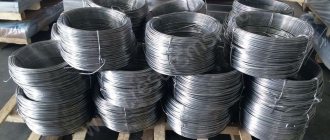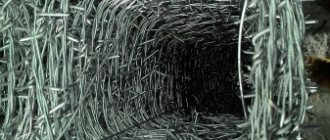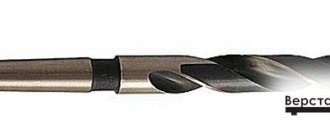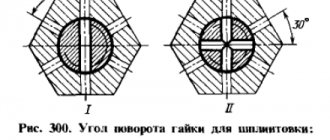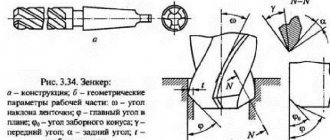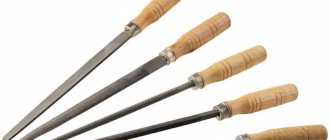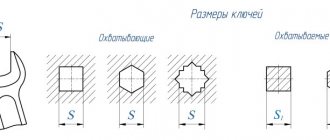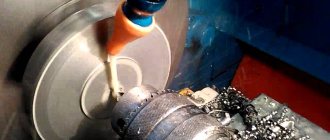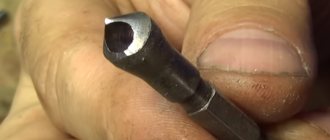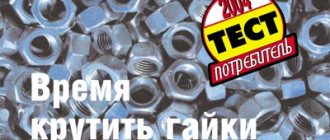Why do you need a step drill for metal?
Any craftsman must have such a tool as a drill, so that when performing this or that work he will be able to drill holes of the required size in certain materials - wood, concrete, brick, plastic, metal. Currently, the market offers specialized drills - designed for processing a specific material. Each of them has unique characteristics and features inherent only to it.
The main characteristic of any drill is its diameter. It determines what size hole can be drilled in a certain material.
Today, dear friends, I want to present to your attention a universal drill that can successfully replace conventional drills.
Intended for metal processing, this drill has a non-standard shape. It also stands out in that it provides, without any additional devices, the ability to drill neat and precise holes on the surface of any material.
For many craftsmen, working with this drill will be new. They differ from others in the quality of drilling, even if the metal is very thin.
Those who have ever tried to drill a hole in metal up to 1 mm thick will understand me: firstly, the drill begins to walk along the surface, and secondly, it begins to bite the edge and the hole no longer turns out to be round, but triangular.
With their help you can drill holes in plastic, pipes, wood, and drywall. In this case, you will not need to use a centering device, which will significantly simplify the work.
This tool is often used to grind an already made hole. With its help, you can quickly remove chips that have formed along the edges, so there is no need for a needle file or sandpaper, which are used to process holes by hand.
The stepped drill has a special structure that looks like progressive channels. Each subsequent channel has a larger diameter than the previous one. In this case, the transition between them is made at an angle of 35-45 degrees. This feature provides a significant increase in the efficiency of processing thin metal (at the level of 50%).
I purchased this tool on the Aliexpress trading platform. The set included three drills with different numbers of steps and different diameters. The first drill has five stages from 4 to 12 mm. The second drill has nine steps from 4 to 20 mm. And the third (the largest) has 15 steps from 4 to 32 mm.
In each of them the step pitch is 2 mm. The step pitch is the diameter of the next largest section, that is, each subsequent step increases the diameter by 2 mm. For example, if in our example the drill is 4-32 mm with a step of 2 mm, then you get 15 steps: 4, 6, 8, 10. and so on up to 32 mm.
Qualities of step drills
The conical tool for drilling holes has the following qualities:
- Processing precision. The use of conventional spiral products does not allow the center of the opening to be precisely maintained. If this has already happened, widening the hole with a stepped tool can correct the situation.
- Versatility. The same conical device is suitable for creating openings of different diameters. Drilling starts with the smallest hole. The transition to each subsequent step increases the size of the opening by 2 mm.
- Parallel chamfering. When drilling with a stepped tool, the edges are processed simultaneously.
Design and characteristics of a cone-step drill
Let's look at the design of the drill itself. The sharp tip with which this product is equipped easily penetrates any metal, no matter what its density. At the same time, the absence of the need to use centering devices significantly simplifies the process of drilling holes.
Using a conventional twist drill with a diameter of 9 mm or more to process thin metal, you are guaranteed to encounter difficulties. The primary problem will be the impossibility of its precise centering. This is due to the fact that its tip is very large. But in order to achieve the goal using this tool, you will have to first drill a smaller hole, and then enlarge it to the required size using an existing conventional twist drill.
Additional convenience of using a step drill is provided by the diameters of its thickenings marked on the sections, so you will not need to use a caliper to determine them.
The non-standard structure of this tool makes it possible to drill round-shaped holes that have different diameters in products made of different metals - steel, including stainless steel, aluminum and others.
You need to know that a metal step drill is designed for drilling holes in thin sheet metal, the thickness of which does not exceed 4-5 mm. The special structure of the tool prevents the occurrence of burrs and provides the ability to grind a finished hole.
From the front, this tool looks like a cone with two cuts. They perform the function of cutting metal - drilling it. After moving to the next step, a chamfer is formed for the hole that was drilled by the previous step.
The tool has a hexagonal shank, which ensures better fastening in the chuck.
Please do not confuse the concepts of step drill and cone drill . They differ from each other in the design features of the working part. A cone drill has a head with a smooth surface, a step drill has a head with special marked steps that have cutting edges. Using a step drill, the diameter of the drilled hole can be selected based on the markings of the sections, and not relying on the “eye gauge”.
Different types of steel are used to produce these tools. The best choice would be a drill marked HSS. It indicates that with its help it is possible to process metal at high speed and at the same time it will not deform even with strong heating.
One of the advantages is the ability to drill holes with different diameter sizes using one tool. No need to change drill bits to do this job. The drill got its name due to its appearance - a smooth transition to the next diameter is ensured by a cone-shaped part made in the form of a step, which allows you to change the size of the hole without stopping work.
Read also: Disassembling a 220V LED lamp
This provides increased convenience if you need to drill a hole of a certain diameter or match it to a cone. A step drill for metal has a number of advantages in comparison with other products with a similar function.
Advantages of step drill
Many craftsmen wonder: is it rational to buy such an expensive tool? After all, the selling price of this product can vary up to 2 thousand rubles, or even more. It is directly influenced by the material of manufacture, the level of strength, the type of coating applied to the working part and other characteristics that are a priority when choosing a drill.
In general, friends, you can write for a long time about how cool the drill is, the instructions even say that the coating is made of titanium nitride (which I doubt, of course, China after all), but for myself I emphasized the following REAL advantages:
- 1) allow you to work with wood, metal, plastic and other materials. The diameter of the holes that can be drilled with their help ranges from 4 to 32 mm (the step between them is 2 mm);
- 2) the tool is truly universal, since the master does not need to purchase a set of single drills in order to drill holes with different diameters;
- 3) marking of diameters on the body - convenient and practical, eliminating the need to use a caliper to measure them;
- 4) the maximum thickness of material that this drill can work with is 5 mm. The edge simply won't allow it anymore. But if you need to make a through hole of the required diameter in metal up to 10 mm thick, then you can be smart and drill a hole on both sides;
- 5) the tail has a hexagon shape, and this ensures better reliability of its fastening in the chuck of an electric drill or screwdriver.
Why does an electrician need a step drill for metal?
Friends, we have gotten to the very heart of the question that you probably had for a long time while reading the article: why does an electrician need a step drill for metal? What does it do to them, since it essentially only works with wires?
But I assure you during the process of installing electrical wiring, such a tool will be very useful for an electrician.
As an example, I can cite the need to drill holes in a metal profile to pull wires inside a plasterboard structure. The thickness of this profile is about 0.5 mm. The diameter of the corrugation that needs to be threaded into the profile is 16 mm. You cannot drill through such thin metal with a regular drill; it will immediately begin to bite and tear, resulting in uneven holes.
And with a step drill you can drill a profile without any problems, and of the required diameter - 16 mm, 20 mm, 25 mm.
Another example where this tool can be used is in electrical panels. Sometimes it becomes necessary to make an additional hole in the shield. For example, for various control buttons, light bulbs, cam switches, oil seals, locks and other accessories.
A real example of how to drill through metal with a step drill . The metal thickness of this electrical panel is 1 mm.
Installation of all these devices also requires drilling holes of considerable diameter in the shield body.
And finally, you can use a step drill to drill holes in various boxes and cable trays to remove wires and cables.
I also came across a distribution box in which the holes for cable outlets were rigidly fixed, that is, they need to be drilled out in order to install a gland or rubber plug. You can suffer and “hollow out” everything with a knife, but why? This universal tool will also help us cope with this task.
From this we can conclude that a step drill for metal is an easy-to-use tool that is guaranteed to be useful in the household.
Personally, I can only leave positive feedback about this tool. In accordance with the price and quality, it is worth the money, and if used wisely, it is a quite suitable tool. Therefore, if you buy it, you will not only not go wrong, but also win.
When choosing a drill bit for a drill, the master is faced with a dilemma: take a set of affordable spiral cutters or purchase expensive cone or step drills. At first glance, it seems that the variable diameter of the latest devices is their only advantage, and the cost is unreasonably high. In fact, these attachments can replace a whole range of devices for a variety of jobs.
Key Features and Applications
The design consists of a working part made of tool steel and a shank. The working surface of step and cone drills for metal is formed by a groove running along a sharp tip in the form of a stepped or smooth cone, respectively. The diameter of the section is marked along the length of the barrel - using the marks, the size of the hole to be made is determined. These cutters can be used to drill through metal no more than 6 millimeters thick, wood, drywall, plastic, fiberglass, glass, etc.
When using a conical drill for metal, burrs do not appear, so the holes do not need to be further processed with a needle file or grinder. The sharp tip eliminates the need for a centering tool and makes it possible to drill into high-density metal. There are also models with an additional layer of abrasive coating, which increases the strength of the edges and extends the service life of the product.
Step drills are used in car repair, construction, laying utility networks, and installing plumbing equipment. Installed on machines, special two-handed drills of pneumatic and electric type, on conventional drills with reliable fixation of the part (otherwise the tool will jam).
What can the color of a drill tell you?
In addition to the markings indicating the composition of the steel and impurities, you need to understand what the color of the drill indicates. This will tell you what additional processing the metal has undergone and how this will affect the characteristics of the equipment. Here are the common types of colors.
Steel gray color
These are the simplest drills without additional coating. If they are left in a humid environment for a long time, they will rust. When drilling, do not put excessive pressure on the tool, otherwise the rod may break.
Golden tone
This color indicates that it has been hardened. The treatment makes the outer part very strong, but increases the internal fragility. Drills hold an edge for a long time, but are prone to breakage. To extend their service life, periodic re-hardening is required.
Golden bright color
Such drills are immediately noticeable on the counter with their bright color. The effect is ensured by titanium surface treatment. The coating reduces wear from friction and promotes long-term operation. The drills belong to the high-strength class and are priced accordingly.
Black color
The steel is steam treated. An inexpensive way to increase external strength while avoiding internal brittleness. The drills hold an edge better and last longer than the gray ones.
Advantages and disadvantages of stepped design
Multi-stage metal drills are classified as a separate subcategory. If the working surface of a cone drill can only be formed by a straight groove, then the multi-stage design allows both straight and spiral translational grooves. The former are easier to sharpen at home, while the latter ensure smooth operation when drilling.
Fixed step diameters make it easier to understand the size of the drilled section. Most models have a step of 2 mm, while the height of the steps varies between cutters. Smooth transitions remove burrs and increase the efficiency of drilling thin-walled metal by 50 percent or more. Thanks to the stepped geometry, the hole is chamfered simultaneously with the hole.
Unlike conical nozzles, stepped nozzles are suitable for working with metal up to 4 mm thick. Other disadvantages include the need to use machines and drills with low rotation speeds (up to 1000 rpm) and high torque, as well as increased sensitivity to distortions that occur during drilling.
Application
A step drill is most often used for processing sheet metal with a thickness of about 4 mm.
The use of the tool allows you to produce high-precision holes, replacing a number of devices, including the extremely common gear crowns. It is thanks to its versatility that the step drill for metal is of increased interest on the part of professional craftsmen. At the same time, the cost of the tool cannot be called affordable for the majority of consumers. An important feature is the ability to obtain a high-quality edge even when processing the thinnest sheets of material. Therefore, the step drill is suitable for working with PVC, plasterboard, plastic, and wood boards. At the same time, to achieve high drilling accuracy, you do not have to resort to the use of centering elements, which greatly simplifies the task.
Selecting a cone drill
The ability to read markings is a key skill for all craftsmen, and conical drills are no exception. The marking indicates the diameters of the holes that the nozzle can make, the step pitch and the length of the product. It also provides information about the metal from which the device is made. For example, the marking Ø4−12/2 HRC 61±2 should be interpreted as follows:
- Ø4 - initial diameter;
- Ø12 - final diameter;
- 2 — pitch of step drill diameters (with the given parameters, it is possible to make holes Ø4, Ø6, Ø8, Ø10, Ø12);
- HRC - steel grade (in the example this is high-quality high-speed steel);
- 61±2 - Rockwell hardness.
Pay attention to the length of individual steps and/or the total length of the working surface. The type of shank plays an important role - the compatibility of the cutter with drilling equipment depends on it. Shanks can be cylindrical, conical or hexagonal.
Read also: Solution for steel bluing
Cone drills are made from more than forty different grades of steel. The average consumer does not need to understand all the differences between them; it is easier to remember the abbreviation HSS. Its presence means that the drill can be used in high-speed processing, and during intense heating it will not deform or lose its strength characteristics.
Having decided on the geometric parameters and material of the nozzle, they look at its color. And this is not a matter of aesthetics, since the color determines what additional processing the product has undergone at the factory:
- The surface of a bright golden color indicates the presence of an abrasive coating, usually titanium nitride (TiN, AlTiN). Spraying significantly extends the service life of the drill (by 25 and 50 percent, respectively), but you will have to pay for increased wear resistance.
- Golden color means that the metal is free from internal stress.
- The black tool is treated with steam, its strength is increased.
- Gray-steel cutters are not subjected to additional processing; other things being equal, their service life and performance characteristics are inferior to the first three types.
How to choose the right step drill?
To choose the right step drill, you need to decide on the purposes for which the tool will be used. Thus, it is necessary to determine what size holes need to be drilled. The values of the smallest and largest diameters that are planned to be made are especially important.
You should also decide on what hand tool or machine the drill will be used. The type of shank that should be on the drill depends on this. Therefore, you should carefully study the drill chuck connector and clearly know the shape and dimensions of the shank. If the shank does not fit the existing connectors, you will have to separately purchase a special adapter.
It is important to decide on the manufacturer and level of the tool. As already noted, bright golden-colored stepped conical drills are made with cobalt and titanium impurities, with an abrasive coating and have high hardness. They will last longer and allow you to work with thick rolled products, stainless and alloy steels.
Look for the HSS designation on the label or packaging, which means the drill is made of high-speed steel. Try not to buy dubious Chinese-made drills.
Characteristics of brands
You should purchase products from trusted stores, giving preference to well-known brands. The quality of steel in cheap no-name drills may not correspond to reality, and dubious stores often sell banal counterfeits at an inflated price. Recommended brands for purchase:
- German: Falon Tech, Karnasch, Ruko, Topcraft;
- Polish: Geko;
- Russian: Attack, Globus;
- Ukrainian: Lezo, Zubr.
Thanks to careful quality control in European factories, Polish and German tools are more efficient and durable, although they are more expensive. Drills from the countries of the former USSR are a compromise between price and quality, but when choosing them you need to make sure that the quality of the metal complies with GOST. It is recommended to refrain from purchasing suspiciously cheap Chinese products.
Self-sharpening
Only the cutting edge (groove) is sharpened. It is prohibited to sharpen the transitions of step drills, as this leads to a change in the geometry of the working surface and the formation of burrs during operation. Improper sharpening leads to a decrease in the quality of the tool, often to complete unusability.
The long service life of conical drills requires periodic re-sharpening. At home, drills with a straight translational groove are the easiest to use. This is done manually using abrasive rods, diamond stones for knives or sandpaper.
Any home craftsman needs to know how to sharpen a step drill for metal with a spiral flute. The process requires the use of sharpening machines, on which the drill is directed so that the abrasive wheel passes exclusively in a spiral. For simultaneous smooth rotation, special devices are used; feeding the drill manually is highly not recommended.
Drills such as cone and step drills are very often confused with each other not only by craftsmen (we don’t take into account metalworking professionals), but also by salespeople in stores. I encountered the latter myself and was surprised by this fact. After all, there are differences, not only obvious visual ones, but also in characteristics and scope of application. Let's take a closer look at this topic.
Cone drills
The shape of the working part of such drills is a conical series of step-by-step annular transitions and a longitudinal-spiral or simply longitudinal groove, forming sharp cutting edges.
This makes it possible to use one tool to produce holes of different diameters. Thus, we save not only time on replacing drills during work, but also money on their assortment. Progressive changes in size are made with smooth transitions between steps. This surface shape promotes easy rotation and increased processing efficiency of sheet materials. The use of high-strength steels for the manufacture of cutting edges on step drills provides them with longer service life without sharpening.
An example of a cone drill
The tool allows you to perform technological operations at a time, which under normal conditions require the sequential use of several tools. The material can be processed at high speed, guaranteeing excellent edge quality, even with the smallest sheet thickness. This form of arrangement of cutting edges makes it possible to drill not only sheet steel, but also soft non-ferrous alloys, wood, plastics, gypsum and other products.
The sharp tip eliminates the need for pre-punching and ensures precise positioning of the tool during operation. Step drills can be installed on stationary machines, portable hand drills, and with adapters, even on a hammer drill and grinder.
Conclusion . Considering the design features and technical capabilities of drills, we can say that the main purpose of this tool is to drill holes in thin sheet workpieces. In addition, they are used to correct defects formed after the use of traditional drills in the form of burrs, misalignment, triangular holes and others. Therefore, such drills are widely used in car repair, plumbing installation, electrical panel manufacturing, construction and finishing work.
How to properly drill holes with a cone drill instructions
To learn how to drill correctly with cone drills, you must first prepare the necessary tools and materials. For work you will need the following materials and tools:
- Blank for drilling. These are sheet steel, plastic, glass, wood, etc. The workpiece must be securely secured in the jaws of a vice or a clamp.
- Drill - any power tool that can develop a rotation speed of 3-5 thousand revolutions per minute is suitable. In this case, it is recommended to attach an additional handle to the drill, which will avoid distortion. Drilling is performed in non-impact mode
- Cone drill of suitable diameter. Depends on the hole that needs to be drilled in the workpiece
After this, we proceed to the actual work. The drilling instructions are as follows:
- The nozzle is fixed in the tool chuck
- Select the location where you want to drill a hole
- The tool is applied to the surface being processed strictly in a perpendicular direction
- The tool motor starts. The first seconds of drilling into metal help center and cut a small hole. As soon as the drill begins to go deeper into the hole, the diameter increases with each subsequent revolution. At the same time, the speed of work execution increases
- The end result is a neat hole without chips, burrs or other defects.
It is enough to try the attachment in action once and then stop using cylindrical drills when processing sheet materials. How a conical drill shows itself in action when drilling plastic, plexiglass, metal and other materials is shown in the video clip.
Source
Types of Step Drills Available for Sale
For the manufacture of cone tools, high-speed steel HSS (High Speed Steel) is used. The types of additional processing of the material and surface can be judged by the color of the metal :
- a regular gray color indicates the absence of additional reinforcement and that you should not count on a long working life;
- black color indicates heat treatment with superheated steam followed by hardening, which increases strength;
- a yellow tint to the surface means the presence of cobalt in the additive, and the ability to work with high-alloy and stainless steels;
- the bright golden surface of the most expensive and durable products with the addition of titanium nitride is classified as a professional tool to achieve maximum service life.
A thin layer of abrasive material made from artificial diamonds or titanium alloys can be applied to the surface of the drill. Such processing does not contradict the requirements of the standards and significantly increases wear resistance.
Step drill in action, video
Existing shapes and sizes
There are three forms of cones : a regular stepped one, in the form of a truncated figure without a guide point, and a figure made up of two conical parts with different angles of inclination of the surface.
Shanks for mounting in the chuck can be cylindrical, triangular or hexagonal. The last two types eliminate rotation, but create the risk of injury when the drill jams in the material being processed. However, with sheet thickness up to 4 mm this usually does not happen.
When choosing a tool, you need to pay attention to the size of the starting and finishing diameters. The first size starts from 4 mm or 7/8”, the latter maximum can reach 38 mm. The successive step steps up to 12 mm are every 1 mm, and after that every 2 mm. The usual step height is 5 mm, but can be found at 3, 4 and 6 mm. The value of this size determines the maximum permissible thickness of the material intended for processing.
Number and shape of working grooves
The number of cutting edges is determined by the number of grooves (not to be confused with steps), which can be from one to three. The shape of the grooves is longitudinal straight or spiral. Experts say that the spiral shape increases the service life of the tool, but makes the sharpening process very difficult. Step drills with three flutes are designed to work at high speeds, and with one recess the processing speed must be reduced.
Read also: Walk-through cutters for wood
The quality of metal processing at low speeds also depends on the number of grooves.
Stepper drill markings
A high-quality branded tool is always marked with an alphanumeric designation, which indicates:
- first, last diameters and step to next sizes;
- steel grade and surface treatment;
- Rockwell hardness of the material.
For example, the inscription Ǿ 4-24/2 HSS-Co 72 says that the first diameter is 4 mm, the last 24 mm, sequential size increments of 2 mm (4, 6, 8 ... 20, 22, 24 mm), made of high-speed steel with the addition of cobalt, Rockwell hardness 56 mm.
In addition, the marking may additionally contain data on the accuracy class and the manufacturer's trademark.
Pros and cons of using step drills
| Advantages | Flaws |
| replacing several drills with one universal drill with different diameters | high price |
| high quality drilled holes | complex sharpening technology |
| possibility of processing thin sheet materials | a cone drill has a conditional accuracy of hole diameter |
| drilling at high drive speeds | |
| reliability and durability | |
| short length, creating more comfortable working conditions | |
| savings on purchasing a complete set of drills |
The most famous manufacturers and prices
A brand very often speaks not only about the quality of products, but also seriously affects their cost. Well-known Western manufacturers guarantee the reliability of their products, but the price of their drills is much higher than domestically produced tools.
Cheap doesn't mean bad ! Among the popular Russian brands producing high-quality stepped cones, the trademarks “Ataka” (ATAKA) and “ZUBR” should be noted. Among the Ukrainian products, Globus conical drills are in demand. The manufacturing level of this instrument is not much different from its European counterparts, but the price can be 2-3 times lower.
The most famous European manufacturers of cone drilling tools are the following brands:
- Makita is one of the best options in terms of cost and quality, manufactured in Japan. Pricing policy within 1,250 rubles. – 14,400 rub. for 1 piece;
- RUKO – country of origin: Germany. It is considered a professional tool, the price, depending on the diameter, is 480 rubles. – 13,500 rubles for 1 piece;
- Geko - also German drills, but not intended for professional work, can be purchased from 200 rubles. per piece;
- DeWALT is an average pricing tool of acceptable quality, cost - from 440 rubles. per piece;
- Bocsh - country of origin: Germany. Price from 4,500 rub. for 1 piece.
*I would like to point out that the figures may have changed since the publication of the article, so they are given for comparison purposes only.
For a more complete review of popular manufacturers, see here .
The same should be called the American brand MILWAUKEE and the Japanese Yato. You can hear only good reviews about their products, and if not for the high cost, then drills from these brands can be universally recommended for wide use.
Chinese products are distinguished by high manufacturing precision, but the quality of metals leaves much to be desired. Tools from the Middle Kingdom are most often short-lived, quickly dull and wear out; you can find a full range of tools on the most popular website for such products, aliexpress.
Video review of a tool purchased on this site
How to make the right choice
The purchase of a step drill should be based on an accurate formulation of the technological problems that must be solved when using it. Therefore, when choosing, take into account :
- The total number of steps, their diameters, pitch and height. The number of transitions of individual models can reach 12. The level of versatility of the tool, speed and quality of drilling depend on this.
- Required drilling diameters during operation, which determine the drill configuration.
- The material used for manufacturing and the option for additional surface treatment. These parameters affect the cost of products and their estimated working life.
- Compliance of diameters with the current requirements of State standards. When working in the metric measurement system, you should not purchase American drills with inch readings.
- Possibility of periodic sharpening in a specialized workshop or on your own.
As already mentioned, the brand also determines the quality, but in this matter you need to independently choose the best option for the ratio of price and reliability of the tool. See a review of popular manufacturers here .
When purchasing tapered step drills, you will be drawn to a very wide range of prices. For example, products made in Russia and Ukraine with a final diameter of up to 20 mm cost an average of 400-500 rubles per piece, and with a final size of 30 mm or more they are sold 2-2.5 times more expensive.
Tools from well-known foreign brands up to 20 mm are sold for no less than 3,000 rubles, and with a finishing diameter of 30 mm for 5,000-7,000 rubles. Therefore, many buyers prefer to buy two or three drills from a domestic manufacturer rather than pay for one foreign product.
Types of wood drills
Depending on the design features, types of wood drills are divided into several categories. The classification is as follows:
- spiral;
- screw;
- feathers;
- Forstner drills;
- crowns;
- milling;
- cork;
- combined;
- countersink.
They are selected depending on the thickness of the material being processed, the diameter and depth of the hole, and the type of shank in the tool.
Attention is drawn to the color of the drill, which changes with different heat treatment technologies:
- Black. In order to increase strength, steam treatment was used.
- Yellow-gold. Treatment was carried out in order to remove surface stresses from the metal.
- Bright gold. Using heat treatment, the surface layer was saturated with titanium nitride.
- Grey. The surface was not sprayed.
Spiral devices
Twist drills are more often than other types used at home. The tool is characterized by a low price and a wide range of diameters - from 3 to 16 mm. There is a point at the end. During operation, it gives it stability, eliminates the possibility of slipping and marks the point at the start of drilling.
Tips can be installed on top: conical or special trimmers. They have the same degree of efficiency, but the magnitude of the perceived load is different. The scorers transfer significant stress to the tool, but the holes are produced with a high degree of accuracy, while the conical head ensures that the drill enters the wood well, without the drill wandering to the side.
Screw (screw)
Another name for this type is auger drill. Due to the fact that the working area resembles an auger, waste is removed well. Advantages:
- Long wood drill. The maximum size is 600 mm, although the most commonly used is 450 mm. Ensures drilling of holes in thick materials with high quality workmanship. Long drills are installed on electric drills and the low speed mode is turned on. It is important to remember that the smaller the diameter of the drill, the shorter it should be. Knowing which drill will be installed, the appropriate operating mode is selected.
- The range of diameter sizes ranges from 3 mm to 52 mm.
The drill must not be bent during operation.
Feather devices
The feather one has a central part made in the shape of a feather. 2 incisors diverge in both directions. On the other side there is a hexagonal tip. The operating rules are as follows:
- Before starting work, use a core to mark the drilling location.
- The equipment used is an electric drill. The number of revolutions is set depending on the diameter of the drill. The larger it is, the lower the revolutions.
- When drilling a deep hole, an extension is used, which is attached to the drill with a lock.
- At the first stage, the contour of the hole is outlined. To do this, the feather part is positioned perpendicular to the surface and pressure is applied with little force.
- Chips are not removed from the groove on their own, so work must be stopped from time to time to remove them.
The tool is the easiest to maintain. Its sharpening is carried out according to the sample. The main thing is to sharpen the central part exactly in the axis. A slight displacement will cause the drill to move to the side.
Forstner drills
The advantage of this type of drilling is the cleanliness of the cut. This is achieved by cutting the fibers around the circumference before starting work. In the future, no chips or scuffs will form on the treated surface.
The tool clearly holds the given direction. In general, as a rule, all drills fix the drilling point with a central tip. Forstner drill - through a cylindrical plane. Thanks to the large surface, the drill cannot move to the side.
A variation of the Fostner drill is the ballerina drill. It consists of a centering element and lateral incisors. Thanks to the adjustable device, the required diameter is set. There is no need to purchase a new tool.
Crowns
Crowns (ring hole method) is the most silent method. It is used when you need to make a large hole in a workpiece of small thickness. The diameter can vary from 19 to 127 mm. Nozzles are sold in sets.
The specificity of the work allows you to drill holes in drywall, fiberboard, chipboard and plastic. The disadvantage is the unreliability of the design. The crown is made of metal 2 mm thick. This allows you to drill no more than 2-3 holes. After this, it is no longer suitable for work.
Milling drills
Using milling drills, you can not only drill holes, but also make grooves. Therefore, they are used in complex machining of parts. The design of the drill consists of a shank and a working part, which is immediately sharpened for the required operation.
The tail section comes in different configurations:
- Triangular. Suitable for three jaw chuck. The shank does not rotate even with high torques.
- Hexagonal. Installation is carried out both in a three-jaw chuck and in a standard one. There is a risk of twisting.
- Conical. For use in production only.
- Tetrahedral. They are rarely used, although there is no turning effect in the cartridge.
Stopper devices
The tool is adapted for making holes for wooden plugs. The holes in which defects have formed due to fallen knots are being processed. In furniture production such defects are unacceptable. Sometimes work is carried out to make countersunk holes in wood for washers or bolt heads.
The plug drill has a cylindrical or conical shape. Installed on a drilling or manual milling machine. The drill cannot be used because the perpendicularity condition will not be met.
Combined type
Using combination drills, stepped holes are made. The number of steps ranges from 2 to 3. A regular twist drill is taken and the sections are ground to a new diameter. Resharpening is allowed for a small difference.
If the range of diameters is impressive, then drills are used that have an alternating cutting edge. A large number of resharpenings are possible here.
Countersink drills
If you need to hide the bolt head in a wooden structure, you can use drills of different diameters. However, it is advisable to combine 2 actions in one.
The design consists of a housing in which the countersink is located. The main drill is attached inside. During the work process, the main hole is first made. In the final stage, they are formed in the upper part of the trench.
Sharpening cone and step drills
Sharpening on professional equipment
During operation, the cutting edges of the tool gradually become dull and require sharpening. The most correct decision in this case is to contact a specialized workshop that has the equipment and specialist to perform such work. By paying a certain amount, you can be sure that the drill will be returned to you in working condition and you will not have to decide on purchasing a new one. This sharpening guarantees:
- maintaining the diameter of all stages,
- maintaining the correct cutting edge angle,
- no overheating.
However, it is not always possible to find craftsmen who will undertake sharpening of a conical step drill. Most workshops refuse, citing the complexity of execution and insufficient experience of workers.
Therefore, quite often you have to sharpen the drill yourself. In this case, the following basic rules must be observed:
- the cutting edges of each step must remain identical with precise dimensions;
- the angle of the edge planes remains unchanged as a result of sharpening;
- the distance between the cutting angle and the opposite side surface on each diameter must be the same;
- sharpening is carried out in the presence of a support stand or with rigid fixation of the drill;
- Only fine-grained abrasives are used for work;
- when performing, one should focus on the maximum possible restoration of the original geometric shapes of the cutting edges.
Good results can be obtained if you use a sharpening machine with an abrasive wheel, the surface of which is covered with sandpaper. The quality of the sharpening performed is determined by the type of chips formed during drilling. With a high-quality result, it will be the same shape and size.
If the grooves have a rectilinear shape, sharpening can be done manually using an even rectangular block, processing several edges at the same time.
If the machine is replaced with a grinder, it must be well fixed in a stationary position and sharpening must be carried out with a strong support bar to hold the drill.
And yet, if you have the opportunity to entrust sharpening to specialists, take advantage of it. Lack of practical skills can lead to damage to an expensive tool and unexpected material costs.
Features of operation
A step drill is a frankly fragile tool.
When starting to process the workpiece, the rod is held perpendicular to the sheet, avoiding distortions. The larger the diameter of the drill, the lower the drill speed should be. To use conical stepped tools, it is best to resort to the use of screwdrivers or so-called drill mixers, which have low torque and moderate rotation speed of the working head up to 1200 rpm.
During operation, the main thing is to ensure that the step drill does not overheat. For these purposes, the use of cooling lubricants is recommended.
